Seven Questions Over Breakfast
with Bonnie Christensen
 September 28th, 2009 by jules
September 28th, 2009 by jules
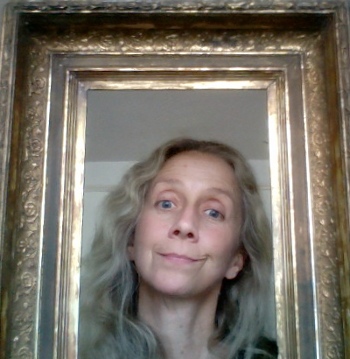 As many sites around the kidlitosphere today celebrate nonfiction titles (as they do every Monday), I am having a cyber-breakfast with author/illustrator Bonnie Christensen, pictured here, who has brought us a handful of engaging nonfiction titles over the years — either illustrating them or both writing and illustrating them herself. Perhaps best known for Woody Guthrie: Poet of the People (Alfred A. Knopf), for which she was given the Horn Book-Boston Globe Honor Award in 2002, she has illustrated fifteen beautiful books for young readers, her primary media being oils and wood engraving or dry point engravings, though she seems to have no fear and has also attempted such artistic adventures as old-skool fresco. (More on that below.)
As many sites around the kidlitosphere today celebrate nonfiction titles (as they do every Monday), I am having a cyber-breakfast with author/illustrator Bonnie Christensen, pictured here, who has brought us a handful of engaging nonfiction titles over the years — either illustrating them or both writing and illustrating them herself. Perhaps best known for Woody Guthrie: Poet of the People (Alfred A. Knopf), for which she was given the Horn Book-Boston Globe Honor Award in 2002, she has illustrated fifteen beautiful books for young readers, her primary media being oils and wood engraving or dry point engravings, though she seems to have no fear and has also attempted such artistic adventures as old-skool fresco. (More on that below.)
You do remember the Woody-Guthrie title (rendered in mixed media) from 2001, right? I do. It blew me away. It was a dramatic and powerful tribute to someone whose music most of us know, whether we realize Woody was behind it or not:
Bonnie’s newest title, which she both wrote and illustrated, is a picture book biography of jazz guitarist Django Reinhardt, published this month by Roaring Brook Press. Django: World’s Greatest Jazz Guitarist has been described by Publishers Weekly as a “sensuous tribute”; indeed, with her oil paintings and spare, lyrical prose, she brings to vivid life the fascinating biography of one of the world’s most renowned jazz guitarists, whose hand was so badly burnt in a fire in Paris in 1928 that doctors thought he would never play guitar again.
“Django Reinhardt,” Bonnie told me, “is a fascinating subject in so many ways. His music is simply ‘the stuff that dream’s are made on,’ from the early Paris dance hall music to the sophisticated jazz style he developed later. When I first read his story, I was hooked. Gypsies, Paris in the ’20s, jazz, and a debilitating injury to overcome—wow! And not only did Django overcome adversity, but {he} turned it to his advantage through artistry and sheer determination.”
(Click to enlarge spread.)
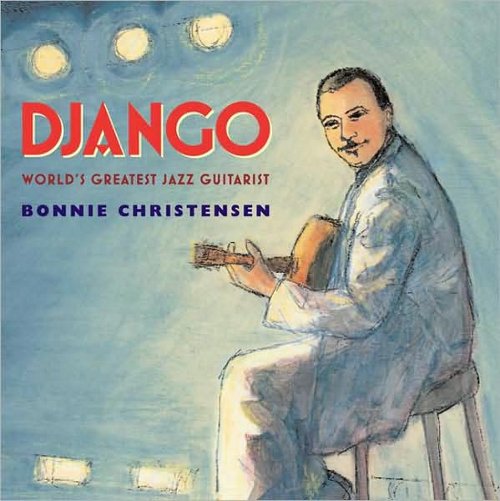
Bonnie’s got some more art from Django—as well as art from many other titles—to share this morning, so let’s get right to it. For our breakfast this morning, she opts for “a toasted English muffin with butter and orange marmalade and home-made espresso with a frightening amount of frothy milk”:
This does not frighten me. I’m all for that, actually, and I think I’ll put out two mugs. Thanks to Bonnie for stopping by — and especially for sharing all the art.
7-Imp: Are you an illustrator or author/illustrator?
Bonnie: Author/illustrator.
7-Imp: Can you list your books-to-date?
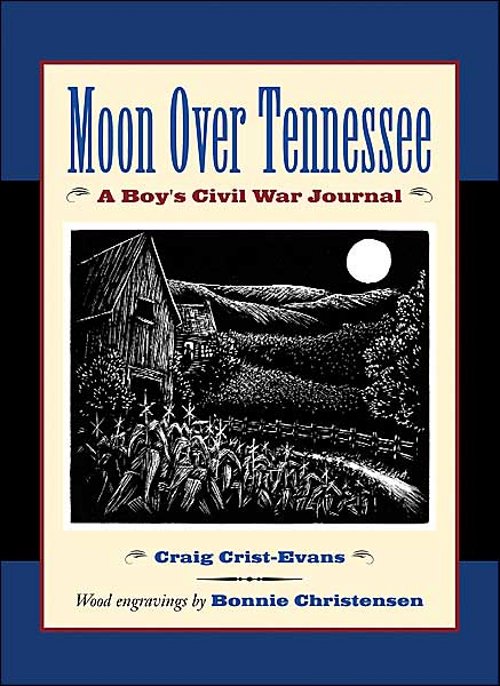
Bonnie:
- Fabulous!: A Portrait of Andy Warhol* — Christy Ottaviano Books, Henry Holt, NY, 2011
- Django* — Neal Porter Books, Roaring Brook Press, NY, 2009
- Ida B. Wells — HarperCollins, NY, 2008
- Magic in the Margins — Houghton Mifflin, Boston, 2007
- Pompeii, Lost and Found — Alfred A. Knopf, NY, 2006
- I, Dred Scott — Simon & Schuster, NY, 2005
- The Daring Nellie Bly* — Alfred A. Knopf, NY, 2003
- In My Grandmother’s House* — HarperCollins, NY, 2003
- Woody Guthrie, Poet of the People* — Alfred A. Knopf, NY, 2001
- Moon Over Tennessee — Houghton Mifflin, Boston, 1999
- The Grapes of Wrath — Folio Society, London, England, 1998
- Rebus Riot* — Dial/Penguin, NY, 1997
- Breaking Into Print — Little Brown & Co., Boston, 1996
- Putting the World to Sleep — Houghton Mifflin, Boston, 1995
- An Edible Alphabet* — Dial/Penguin, NY, 1994
- Green Mountain Ghosts — Houghton Mifflin, Boston, 1994
(* denotes books also authored)
(Alfred A. Knopf, 2001)
(Click each spread to enlarge.)
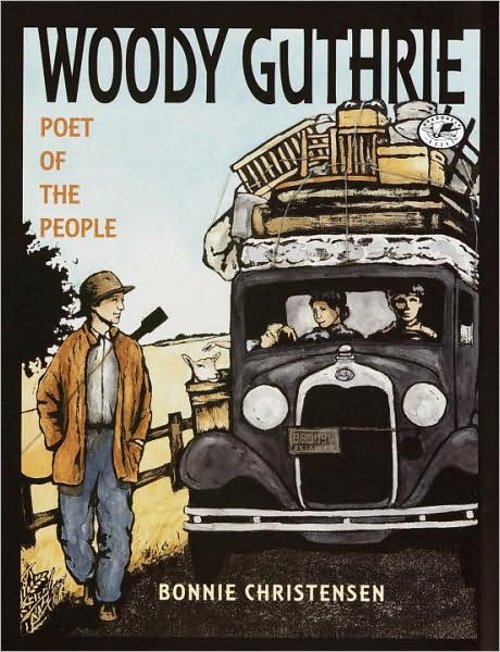
7-Imp: What is your usual medium, or––if you use a variety—your preferred one?
Bonnie: I’m a chameleon, as far as medium. I like to choose a medium to fit the text, which has taken me from pen-and-ink with watercolor for Nellie Bly to classic fresco for Pompeii, Lost and Found.
Click each image to enlarge.
And click here to see a slide show of Bonnie’s fresco-on-linen process.
Since my roots are in printmaking, many of my books are illustrated in wood engraving or dry point engravings. For Django, I used oils and oil pastels which I’ve come to love; for my next book—Fabulous!: A Portrait of Andy Warhol {images further below in interview}—I used photo collage transferred to canvas and then painted with oils. So, you can see I’m all over the place. I blame this on loving the process.
(Click to enlarge spread.)
unique and new. / Keeps it to himself.”
(Click to enlarge and see the spread from which the illustration comes.)
(Roaring Brook Press, September 2009)
7-Imp: Where are your stompin’ grounds?
Bonnie: I’ve just moved from Vermont into an arts-and-crafts bungalow in Wilson, North Carolina, home of Vollis Simpson’s amazing gigantic whirligig park.

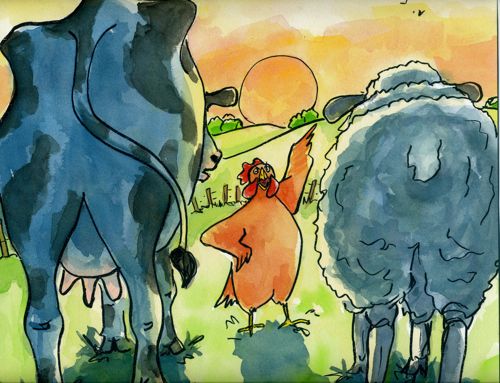
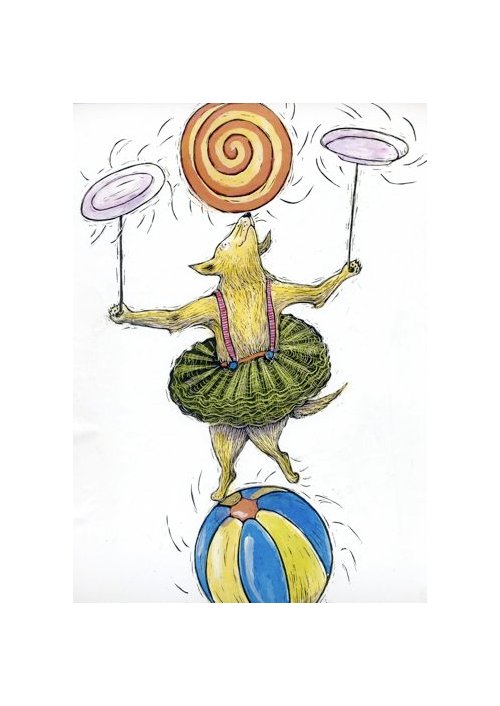
7-Imp: Can you briefly tell me about your road to publication?
Bonnie: My road to publication was long and winding. I was encouraged by my father to be an artist but insisted on working in theatre. After about thirteen years in New York, I moved to Vermont, married, and found myself at home with an infant and piles of books. “Hey, I’d like to do that!” I worked as a letterpress printer at Shelburne Museum and eventually wrote, illustrated, printed, and bound a book for my daughter. Everyone said, “oh, you should try to get that published!” That book never made it across the starting line, but it got me in the door and I was lucky enough to meet a wonderful editor at Dial who published my first book.
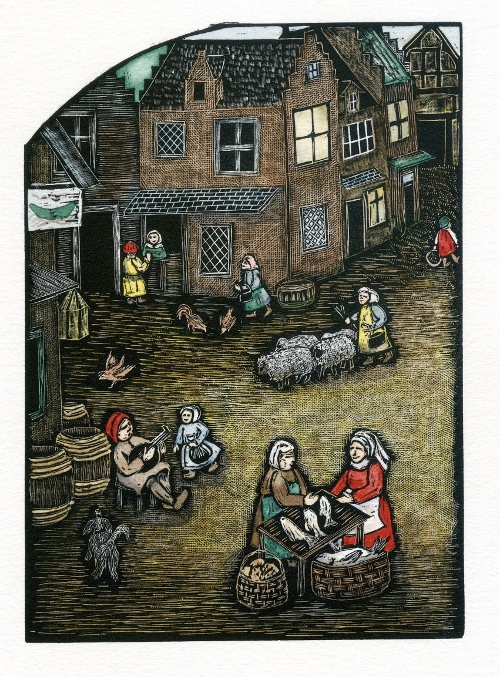

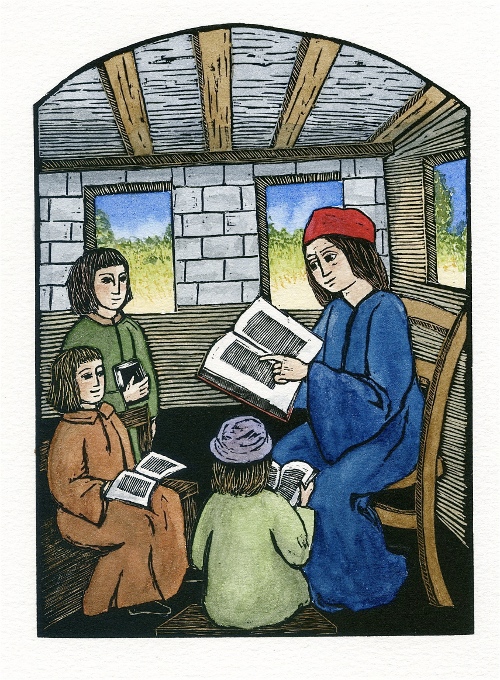
by Stephen Krensky (Little Brown & Co, 1996)
7-Imp: Can you please point me to your web site and/or blog?
Bonnie: www.bonniechristensen.com.

7-Imp: If you do school visits, tell me what they’re like.
Bonnie: School visits really re-charge my battery. I do a pretty typical “how a book gets made” slide or PowerPoint; then I do a woodblock printing demonstration. The kids look skeptical as I roll the ink on the block and sometimes wriggle as I hand-burnish the print. Then, when the moment comes and I finally pull the print off the block, they’re astounded and all want to do it themselves. I love that.

7-Imp: Any new titles/projects you might be working on now that you can tell me about?
Bonnie: I have a picture book bio, Fabulous!: A Portrait of Andy Warhol (Christy Ottaviano Books, Henry Holt), coming out and currently working on illustrations for The Princess of Borscht (Neal Porter Books, Roaring Brook Press), a charming and humorous manuscript by the wonderful Leda Schubert. It’s great to work on a story with such vivid and funny characters! {Ed. Note: Sketches from The Princess of Borscht are below in the interview.}
Click each spread to enlarge:
In printmaking, I’m working on a series of prints called “Big Money.” The dime print (drypoint engraving) is 24″ square and the dollar bill (wood cut) will be about 3′ x 5′. Quite simply, this series is answering the question: How can an artist make big money?


 Our table’s set—Bonnie’s home-made espresso, mmm—and breakfast is ready. Time for the Big Seven. Let’s keep at it…
Our table’s set—Bonnie’s home-made espresso, mmm—and breakfast is ready. Time for the Big Seven. Let’s keep at it…
1. 7-Imp: What exactly is your process when you are illustrating a book? You can start wherever you’d like when answering: getting initial ideas, starting to illustrate, or even what it’s like under deadline, etc. Do you outline a great deal of the book before you illustrate or just let your muse lead you on and see where you end up?
Bonnie: If I’m writing and illustrating, I always complete the manuscript first, then step back and change hats. Ideally, I can let the manuscript ferment for a while before tackling it from the illustrator perspective. With illustrating, I need to lay the whole thing out before getting started. I break the manuscript up into what I see as the “dramatic actions” and try to pace it for suspense. Then I write down ideas on my layout board. This is where I never know what happens. Sometimes I draw little thumbnails on the layout. Sometimes I use blank index cards to correspond to the pages, and sometimes I take a sheet of copier paper and start drawing. Sometimes it’s a combination of all of the above. I don’t worry about sizing, since the photocopier can help me re-size to fit the pages. The hardest part is keeping the sense of liveliness that happens with the thumbnails in the final drawings and final art.
a forthcoming title from Roaring Book Press
(Click to enlarge.)
(Click to enlarge.)
2. 7-Imp: Describe your studio or usual work space.
Bonnie: My studio is in my home with lots of windows looking onto the street, so I can see the world go by and….procrastinate. Prior to this year, I worked in the corner of my bedroom, and sometimes my painter friend, Lance, would take pity on me and share his studio space at a nearby college.
3. 7-Imp: As a book lover, it interests me: What books or authors and/or illustrators influenced you as an early reader?
Bonnie: I had a lot of Little Golden Books, but the one that fascinated me most was a Mary Poppins story, which posed a question at the end and asked the reader if they could answer it. In an age when children were “seen and not heard,” that ending resonated in my mind and still does. Mr. Popper’s Penguins was a favorite — and also Phantom Toll Booth. My grandmother read Dickens aloud. In sixth grade, my reading teacher took away Nancy Drew and assigned me Jane Eyre. I thought she was wicked but finished Jane Eyre in one weekend, and after that I was her reading slave.
4. 7-Imp: If you could have three (living) illustrators—whom you have not yet met—over for coffee or a glass of rich, red wine, whom would you choose?
 Bonnie {pictured here is one of Bonnie’s unpublished samples}: I’m a bit greedy, so if I’m getting some of my favorite author/illustrators to visit I’m going to make them stay for dinner and dessert, and I’m also going to invite more than the allowed number for proper seating arrangement. They would be Quentin Blake, Susan Meddaugh, Mordicai Gerstein, Mini Grey, Simms Taback, and Emily Gravett.
Bonnie {pictured here is one of Bonnie’s unpublished samples}: I’m a bit greedy, so if I’m getting some of my favorite author/illustrators to visit I’m going to make them stay for dinner and dessert, and I’m also going to invite more than the allowed number for proper seating arrangement. They would be Quentin Blake, Susan Meddaugh, Mordicai Gerstein, Mini Grey, Simms Taback, and Emily Gravett.
5. 7-Imp: What is currently in rotation on your iPod or loaded in your CD player? Do you listen to music while you create books?
Bonnie: Upcoming on my IPod shuffle — Hoagy Charmichael, Angelique Kidjo, Venice String Quartet, Billie Holiday, Django Reinhardt!!, Tartini, The Devil’s Sonata, Astor Piazzolla, Frank Sinatra, Mahler’s 4th, Chet Baker, and The Fairfield Four.
 When I’m writing, I loathe any sound, but when I’m illustrating I try to listen to something related to the subject matter of the book. For Grapes of Wrath, I listened to Woody Guthrie, which eventually led to the idea of writing a book about him.
When I’m writing, I loathe any sound, but when I’m illustrating I try to listen to something related to the subject matter of the book. For Grapes of Wrath, I listened to Woody Guthrie, which eventually led to the idea of writing a book about him.
{Ed. Note: Pictured right is an illustration from Magic in the Margins: A Medieval Tale of Bookmaking by W. Nikola-Lisa (Houghton Mifflin, 2007).}
6. 7-Imp: What’s one thing that most people don’t know about you?
Bonnie: I have a certificate in plumbing.
{Also}, I hide my daughter’s name (Emily) on most of my book jackets. I know this is not at all original, and sometimes something happens with the design and the name gets cut or shortened (“Em” on Nellie Bly), but usually she’s there and, these days, not too hard to find.
7. 7-Imp: Is there something you wish interviewers would ask you, but never do? Feel free to ask and respond here.
Bonnie: What is the strangest job you’ve ever had?
That would be hot-gluing fur and feathers on rubber chickens. Okay, the hot-gluing was just part of my job building props for the play Yentl at the Chelsea Theatre in Brooklyn many years ago.

7-Imp: What is your favorite word?
Bonnie: “O.K.” It’s possibly the most frequently used word in the world, because it appears (with the same meaning) in so many languages, but that’s not why I like it.
7-Imp: What is your least favorite word?
Bonnie: “No.”
7-Imp: What turns you on creatively, spiritually or emotionally?
Bonnie: Verbal bantering with witty friends, playing violin, research, walking in my own front door, living in a foreign country, reading a knock-out book, and experimenting with process.
7-Imp: What turns you off?
Bonnie: Local, national, and world news.
7-Imp: What is your favorite curse word? (optional)
Bonnie: It’s actually a three-word phase, involving water fowl, and is really quite rude.
 7-Imp: What sound or noise do you love?
7-Imp: What sound or noise do you love?
Bonnie: My daughter practicing clarinet {pictured here}. Yes, really.
7-Imp: What sound or noise do you hate?
Bonnie: Car stereo systems with more bass than God.
7-Imp: What profession other than your own would you like to attempt?
Bonnie: Musician or archaeologist.
7-Imp: What profession would you not like to do?
Bonnie: Working in a whoopee cushion factory.
7-Imp: If Heaven exists, what would you like to hear God say when you arrive at the Pearly Gates?
Bonnie: “Don’t worry. I’ll keep the bass down.”

The spiffy and slightly sinister gentleman introducing the Pivot Questionnaire is Alfred. He was created by Matt Phelan, and he made his 7-Imp premiere in mid-September. Matt told Alfred to just pack his bags and live at 7-Imp forever and always introduce Pivot. All that’s to say that Alfred is © 2009, Matt Phelan.
Images of Bonnie, her studio, and all artwork and sketches are courtesy of Bonnie Christensen. All rights reserved.
Except…The illustrations from DJANGO: WORLD’S GREATEST JAZZ GUITARIST were provided by the publisher, Roaring Brook Press, New York, NY. Copyright © 2009 by Bonnie Christensen.
Today’s Nonfiction Monday round-up is being hosted by none other than Wendie at Wendie’s Wanderings, if you’re so inclined to read about some other nonfiction titles today.
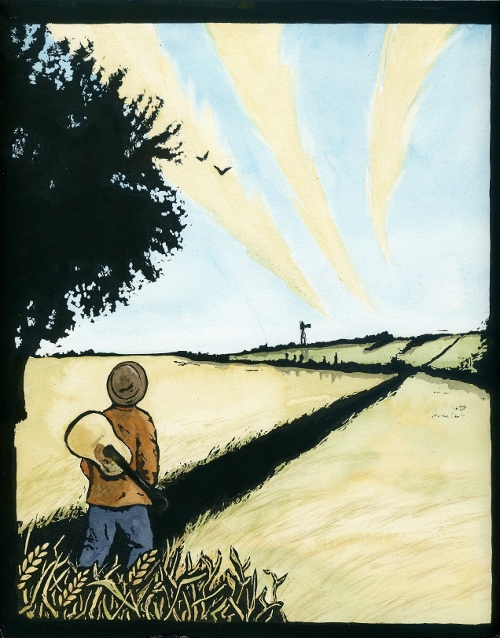
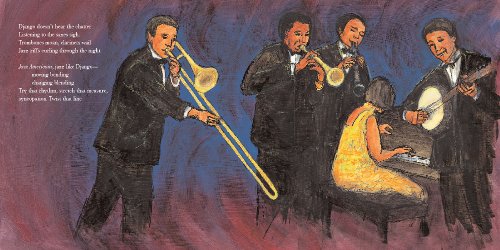
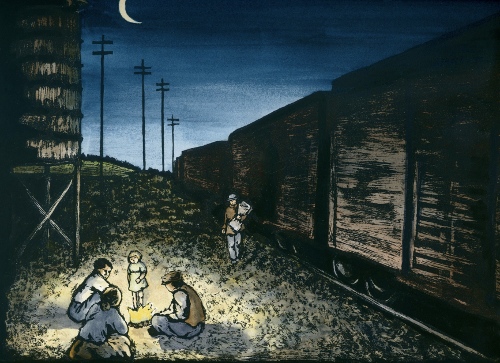

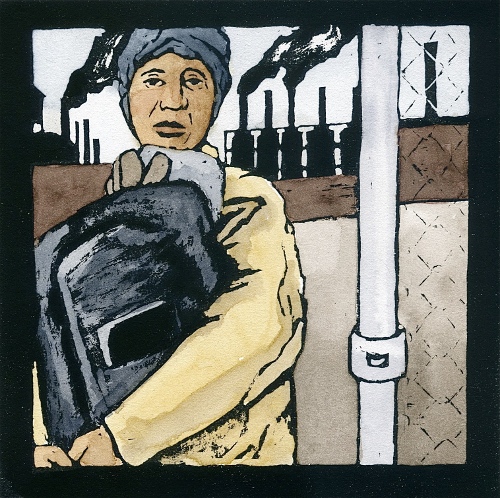

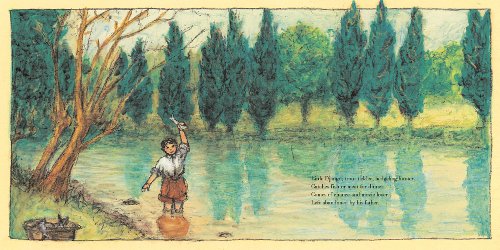
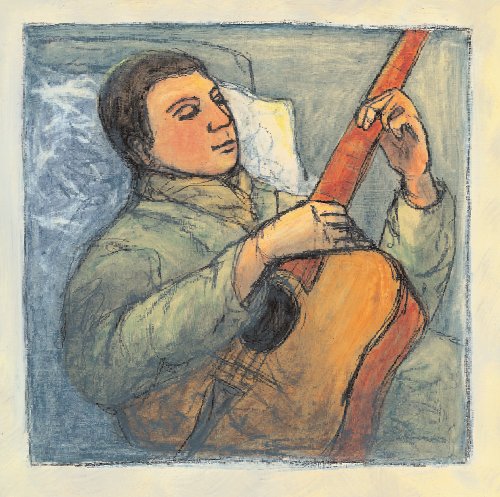


WOW, wow, wow. I so very much wish to be an artist, especially when I see the work of people who can switch around through mediums. Linen! Woodcutting! That Steinbeck woodcut is perfect — all those uncompromising planes of a weathered face — so, so beautiful.
*sigh*
Thank you so much for bringing Bonnie Christensen by for breakfast. What a lovely way to start the day, and the week.
Thank you for all the rich words and pictures, and traveling through time.
I love you both. Rock on.
Wren
You are so creative and brilliant. I wish I could be you just one day.
What can I say — my friend Bonnie Christensen is a genius AND she’s funny!
Fun, fun, fun.
Alice
I would love to work in a Whoopee Cushion factory. I got more laughs with my family spending .99 cents on a whoopee cushion. That is the difference between being a daugher of Judd than a daughter of Theo.
Amazing work! Thanks for another glimpse into the inner and outer world of a brilliant creator.
Thanks for sharing this wonderful journey. The photos of the cats makes me wonder–what do they sit there and think about while you’re busy creating these inspired imagines?
Wonderful diverse set of inspirations and work. Cool.
Great interview with the lovely and brilliant Bonnie!
Bonnie’s appreciation for all things that are fun and interesting to her, and her incredible talent to make it all come alive for the reader in so many different kinds of media make her a national treasure!! x
Wonderful! Thanks for sharing so much Bonnie!
Fabulous interview with an amazing and talented artist/writer! Can’t wait to read and see Django and The Princess of Borscht and Fabulous: A Portrait of Andy Warhol.
[…] publication, The Bluegrass Special, contacted me to get permission to post excerpts from my 2009 interview with Bonnie Christensen for their March issue on Django Reinhardt. Here’s the piece. Neat, huh? (And more 7-Imp stuff […]
[…] column. Below is the artwork only. Oh! But also: Bonnie Christensen, who visited me for breakfast here in 2009, not only shares some artwork below from her picture book biography of Andy Warhol, but she […]
I am soooooo happy that Bonnie is in the world making more and more delightful artwork. Great interview.
[…] from Bonnie Christensen’s Plant a Little Seed(Neal Porter/Roaring Brook, May […]
very sad news. Thanks for re-posting this.
Thank you for the posting. With the sad news of her passing, the posting provided a remembrance of her dedication to the craft of author/illustrator.
A little over a year after my mom’s passing, I am so grateful to have this “sound” bite to come back to. Thank you for keeping her smarts and spirit alive through this post!
Also, her website can be found at a new domain, if you wouldn’t mind updating the piece (I think the old one is now a spam-y USB charger store??) http://www.bonnietchristensen.com
Emily, it will be my pleasure to update that link, which I’ll do now. I’m still so sorry for your loss. What a huge talent she was.